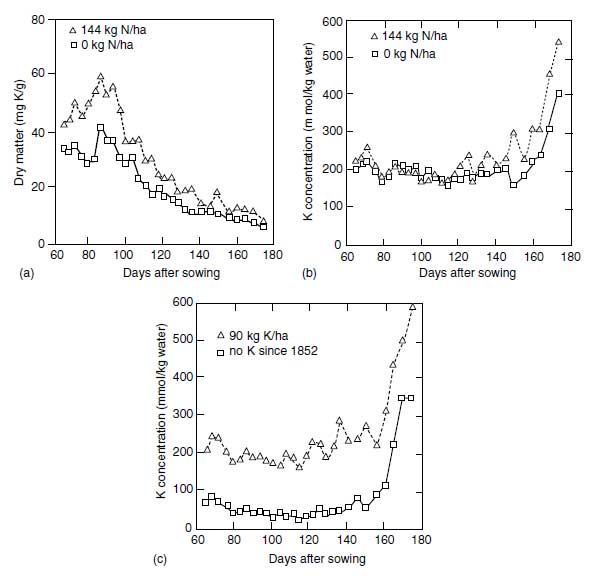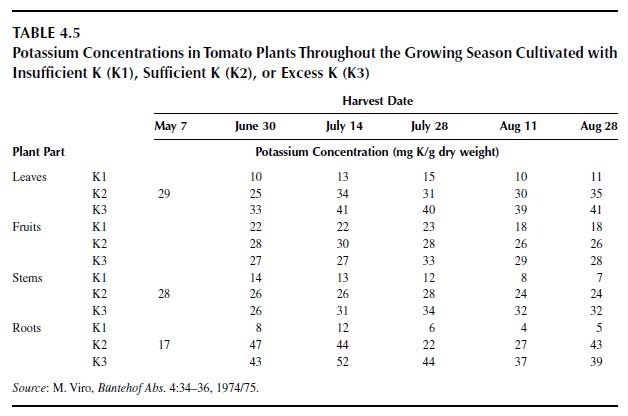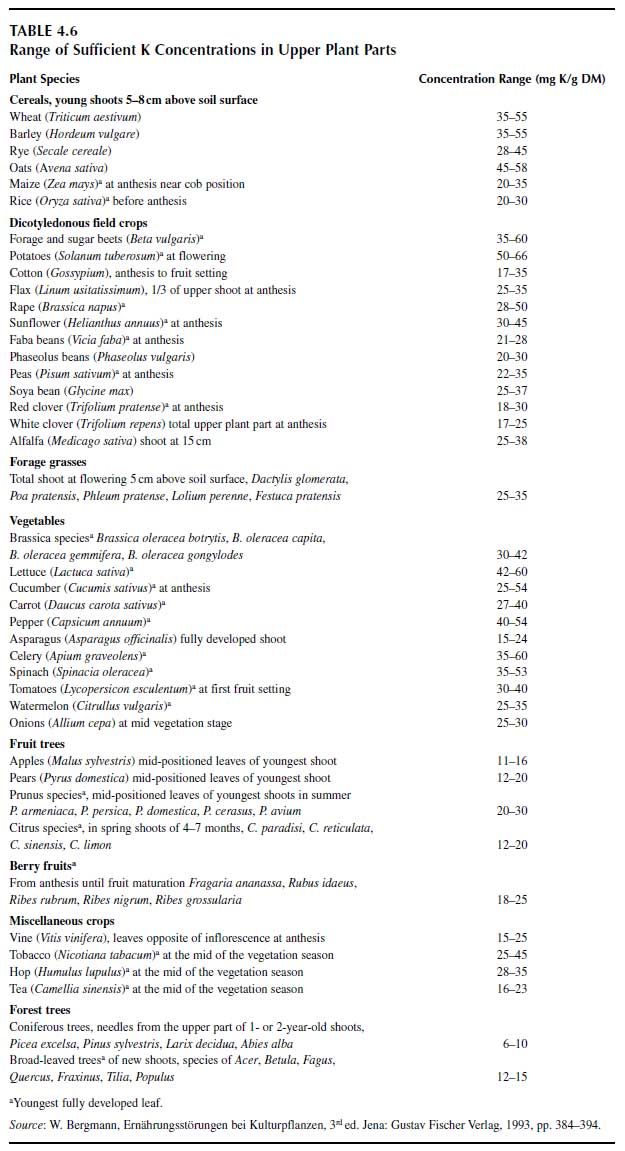Concentrations of Potassium in Plants
Potassium in plant tissues is almost exclusively present in the ionic form. Only a very small portion of total K+ is bound by organic ligands via the e- pair of O atoms. Potassium ions are dissolved in the liquids of cell walls, cytosol, and organelles such as chloroplasts and mitochondria and especially in vacuoles. From this distribution, it follows that the higher the K+ content of a tissue the more water it contains. These tissues have a large portion of vacuole and a low portion of cell wall material. Plant organs rich in such tissues are young leaves, young roots, and fleshy fruits. Highest K+ concentrations are in the cytosol, and they are in a range of 130 to 150mM K+ (76). Vacuolar K+ concentrations range from about 20 to 100 mM and reflect the K+ supply (30). The high cytosolic K+ concentration is typical for all eukaryotic cells (29), and the mechanism that maintains the high K+ level required for protein synthesis is described above.If the K+ concentration of plant tissues, plant organs, or total plants is expressed on a fresh weight basis, differences in the K+ concentration may not be very dramatic. For practical considerations, however, the K+ concentration is frequently related to dry matter. In such cases, tissues rich in water show high K+ concentrations, since during drying the water is removed and the K+ remains with the dry matter. This relationship is clearly shown in Figures 4.7a to 4.7c (77). In Figure 4.7a, the K+ concentration in the tissue water of field-grown barley is presented for treatments with or without nitrogen supply. Throughout the growing period the K+ concentration remained at a level of about 200 mM. In the last phase of maturation, the K+ concentration increased steeply because of water loss during the maturation process.
The K+ concentrations in the tissue water were somewhat higher than cytosolic K+ concentrations. This difference is presumably due to the fact that in experiments the water is not removed completely by tissue pressing. In Figure 4.7b, the K+ concentration is based on the dry matter. Here, in the first phase of the growing period the K+ concentration increased, reaching a peak at 100 days after sowing. It then declined steadily until maturation, when the concentration increased again because of a loss of tissue water. In the treatment with nitrogen supply, the K+ concentrations were elevated because the plant matter was richer in water than in the plants not fertilized with nitrogen. Figure 4.7c shows the K+ concentrations in the tissue water during the growing period for a treatment fertilized with K+ and a treatment without K+ supply. The difference in the tissue water K+ concentration between both treatments was high and remained fairly constant throughout the growing period, with the exception of the maturation phase.
From these findings, it is evident that the K+ concentration in the tissue water is a reliable indicator of the K+ nutritional status of plants, and it is also evident that this K+ concentration is independent of the age of the plant for a long period. This fact is an enormous advantage for analysis of plants for K+ nutritional status compared with measuring the K+ concentrations related to plant dry matter. Here, the age of the plant matter has a substantial impact on the K+ concentration, and the optimum concentration depends much on the age of the plant.
Until now, almost all plant tests for K+ have been related to the dry matter because dry plant matter can be stored easily. The evaluation of the K+ concentration in dry plant matter meets with difficulties since plant age and also other factors such as nitrogen supply influence it (77). It is for this reason that concentration ranges rather than exact K+ concentrations are denoted as optimum if the concentration is expressed per dry weight (see Table 4.6). Measuring K+ concentration in the plant sap would be a more precise method for testing the K+ nutritional status of plants.
Figure 4.7c shows the K+ concentration in tissue water during the growing period for treatments with or without K fertilizer. There is an enormous difference in tissue water K+ concentration since the treatment without K has not received K fertilizer since 1852 (Rothamsted field experiments). Hence, potassium deficiency is clearly indicated by the tissue water K+ concentration. The increase in K+ concentration in the late stage is due to water loss.
 |
| FIGURE 4.7 Potassium concentration in aboveground barley throughout the growing season of treatments with and without N supply (a) in the dry matter, (b) in the tissue water, and (c) in the tissue water with or without fertilizer K. (Adapted from A.E. Johnston and K.W. Goulding, in Development of K Fertilizer Recommendations. Bern: International Potash Institute, 1990, pp. 177-201.) |
If the K+ supply is in the range of deficiency, then the K+ concentration in plant tissue is a reliable indicator of the K+ nutritional status. The closer the K+ supply approaches to the optimum, the smaller become the differences in tissue K+ concentration between plants grown with suboptimum and optimum supply. Such an example is shown in Table 4.5 (65). Maximum fruit yield was obtained in the K2 treatment at K+ concentrations in the range of 25 to 35 mg K/g dry matter (DM). In the K+ concentration range of 33 to 42 mg K/g DM, the optimum was surpassed.
The optimum K+ concentration range for just fully developed leaves of 25 to 35 mg K/g DM, as noted for tomatoes, is also noted for fully developed leaves of other crop species, as shown in Table 4.6 (52). For cereals at the tillering stage, the optimum range is 35 to 45 mg K/g DM. From Table 4.5, it is evident that stems and fleshy fruits have somewhat lower K+ concentrations than other organs. Also, roots reflect the K+ nutritional status of plants, and those insufficiently supplied with K+ have extremely low K+ concentrations. Young roots well supplied with K+ have even higher K+ concentrations in the dry matter than well-supplied leaves (see Table 4.5). The K+ concentrations for mature kernels of cereals including maize ranges from 4 to 5.5 mg/g, for rape seed from 7 to 9 mg/g, for sugar beet roots from 1.6 to 9 mg/g, and for potato tubers from 5 to 6 mg/g.
 |
 |




